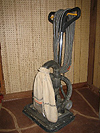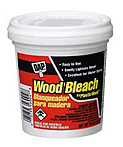Wood Maintenance
When choosing what material to build with, maintenance will be your number-one consideration and could ultimately be the determining factor. Cost also plays a large role in deciding, but how much maintenance you are willing to commit to needs to be weighed out.
You do not want to make a choice based on price alone that will later affect how much you enjoy your new outdoor living area. You may opt to invest more in the beginning in order to lower your maintenance costs in the future.
There is no deck that is free of all maintenance. The closest thing to a maintenance free deck is composite decking. It usually only needs routine cleaning. Initially composites tend to be the most expensive option; however, as the years go by and you are not spending money on stain or replacement boards, the gap will narrow. However, the heat that composite absorbs is much greater than that of a natural wood deck.
Even though you are gaining lower maintenance, you will lose the natural look of real wood. If the look of real wood is something that you cannot live without, then choosing the right wood will play a huge role in the amount of maintenance the deck will require. All wood decking requires regular maintenance if you want to keep it from weathering or turning gray.
The UV rays from the sun will cause any wood surface to fade to a silvery gray. The only way to prevent this is to apply a stain. This will block out the damaging rays from the sun. Most stains are also sealers. Sealing wood is also an important step to take in protecting the wood from the damaging effects of moisture. As wood absorbs water, it swells. When it dries out, it shrinks. This process causes the wood fiber to tear, or “split”. The degree and size of these splits will also vary greatly from one species of wood to another. How stable a given type of wood is will determine how badly it splits. Some wood species also have naturally occurring preservatives that protect them from decay and degradation. All of these factors determine how a wood will hold up as it ages. Of the three most commonly used woods, redwood is the most stable and rot resistant wood. Western Red Cedar is the very similar to redwood, but varies in appearance. Treated pine is the least stable wood to use for the deck surface. You will see the more splitting and cupping due to the nature of pine.
Maintenance Procedures
Maintaining any exterior surface, whether it is siding, decking, or even an arbor or playset, is made easier when done with a preventative approach. If you do routine maintenance when it is visibly needed and do not let the finish degrade too far, the project is made much easier. It is always easier to apply a maintenance coat with a light cleaning or sanding rather than having to bring the finish back down to bare wood and start over.
This will ensure that the least amount of damage is done to the wood itself by the elements, and that the finish is performing to its highest potential. On average a deck in direct sunlight will require attention every year to two years. If it is under cover that span will be greater. If a high quality siding finish is used, vertical surfaces could go as long as five or six years in optimal conditions.
 The best and easiest method of preparing a deck to be stained is to sand with 80 or 100 grit sand paper. This is true of new, weathered, and previously stained wood. Sanding new wood will remove the mill glaze and open the pores so that the stain can soak in better. As a result, the stain will last longer and the wood will require less maintenance. Gray, weathered wood can be sanded down to look new with ease. Once clean, fresh wood is exposed, it is like working with new wood. On previously stained wood, sanding will remove the old stain that is not adhering and also open the pores to allow the stain to absorb better. The real benefit to sanding is that you can clean the dust off and stain in the same day. This job can be made very easy with the floor sander that we keep in our rental department.
The best and easiest method of preparing a deck to be stained is to sand with 80 or 100 grit sand paper. This is true of new, weathered, and previously stained wood. Sanding new wood will remove the mill glaze and open the pores so that the stain can soak in better. As a result, the stain will last longer and the wood will require less maintenance. Gray, weathered wood can be sanded down to look new with ease. Once clean, fresh wood is exposed, it is like working with new wood. On previously stained wood, sanding will remove the old stain that is not adhering and also open the pores to allow the stain to absorb better. The real benefit to sanding is that you can clean the dust off and stain in the same day. This job can be made very easy with the floor sander that we keep in our rental department.
 The other method of preparing to stain wood is to clean it with a combination of water and chemicals. The most common product used where stripping is not required is TSP (Tri-Sodium Phosphate). This is a good, general-purpose detergent that can be used to remove the any old finish that is not adhering to the wood along with dirt and grime. Rinsing with a pressure washer ensures that no soapy residue remains. If you do not have access to a pressure washer, we also keep one for rent.
The other method of preparing to stain wood is to clean it with a combination of water and chemicals. The most common product used where stripping is not required is TSP (Tri-Sodium Phosphate). This is a good, general-purpose detergent that can be used to remove the any old finish that is not adhering to the wood along with dirt and grime. Rinsing with a pressure washer ensures that no soapy residue remains. If you do not have access to a pressure washer, we also keep one for rent.
 For gray, weathered wood there is a chemical called Oxalic Acid. It is referred to as wood bleach and is less harmful to wood than regular Chlorine Bleach. It comes in both powder form or in a chemical solution. If you need to remove all of the finish from a deck, a stripper is probably necessary. The steps are very similar to cleaning. You apply the stripper with a roller or a sponge-mop. Then you allow the product to sit on the surface for the allotted time in order to loosen up the finish. Next rinse the deck, and follow up with a wood brightener if necessary. . Once the wood has dried for at least a couple of days, you are ready to apply the stain.
For gray, weathered wood there is a chemical called Oxalic Acid. It is referred to as wood bleach and is less harmful to wood than regular Chlorine Bleach. It comes in both powder form or in a chemical solution. If you need to remove all of the finish from a deck, a stripper is probably necessary. The steps are very similar to cleaning. You apply the stripper with a roller or a sponge-mop. Then you allow the product to sit on the surface for the allotted time in order to loosen up the finish. Next rinse the deck, and follow up with a wood brightener if necessary. . Once the wood has dried for at least a couple of days, you are ready to apply the stain.


